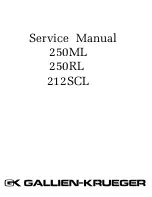
DCi Series
Power Amplifiers
Operation Manual
page 14
70/100 VRMS (switch A)
This switch selects either 70 or 100 VRMS operation for all outputs currently selected for Hi-Z mode. (See the section below, Hi-Z.) Default position is 70 V (OFF). In 70 V
and 100 V mode, a voltage limiter circuit is enabled. NOTE: When bridged Hi-Z mode is implemented, selected voltages are doubled to 140V or 200V.
Power Save (switch C)
The Power Save switch enables the Auto-Standby function. In OFF position, the Auto Standby feature is disabled; amplifier power on/off is controlled by the front panel
switch or the AUX port ground closure.
In the ON position, Auto Standby is enabled. If the amplifier input does not see signal for 30 minutes, the amplifier will power down to consume less than 1W of power.
When -40dBu of input signal is applied, then the amplifier will power up for activation. The power up sequence will take approximately 4 - 5 seconds.
Per Channel Settings
Note: The following text and illustrations refer to one channel pair, channels 1 and 2. Settings and functions are identical for other channels pairs (3/4, 5/6, 7/8) in
multichannel models.
Hi-Z
Each channel of the channel pair is individually selectable for Lo-Z or Hi-Z operation. When Hi-Z operation is selected (ON, up) a 35Hz high pass filter is selected
automatically. The filter can be changed to 70Hz. Contact your local Crown service center for detailed instruction for this change. When a channel pair is configured for
bridged Hi-Z mode, only switches assigned to the odd-numbered channels (1,3,5,7) are active; switches for the even-numbered channels (2,4,6,8) are disabled.
Channel Attenuators
Each channel is supplied with a logrithmic 21-position detented input attenuator. Use a flat-blade screwdriver to set input level. Attenuation is from -95 dB (full counter-
clockwise) to 0 dB (full clockwise).
Global Settings
Amplifier Status (switch B)
The Amplifier Status works with life safety or supervisory monitoring and control systems where notification of an amplifier fault is necessary. The Amplifier Status produces
a signal (“heartbeat”) when the amplifier is operating within standard working parameters. If the amplifier enters a fault or thermal condition, the Amplifier Status signal will
terminate. This feature is always on and available when the amplifier is ready to deliver audio in selected mode through the AMP STATUS line on the AUX port.
The Amplifier Status signal is selectable:
• ON – the microcontroller will send a 2 Hz pulse to the “AMP STATUS” AUX port line.
• OFF – the microcontroller will send a logic high level to the “AMP STATUS” AUX port line.
The voltage output of the Aux Port is 5VDC at 0.9 milliamps. This TTL or similar signal can then be connected to an interface to indicate the amplifier status to a supervisory
control system.
Amp status can be used in a variety of life safety applications
Position
0
1
2
3
4
5
6
7
8
9
10
Typical
Attenuation
0
0.1
3
6
8
9.5
11
12.5
14
15.5
16.5
Position
11
12
13
14
15
16
17
18
19
20
Typical
Attenuation
17.5
19
20.5
22.5
24.5
27.5
32
42
90
95
Содержание 4300
Страница 32: ......















































